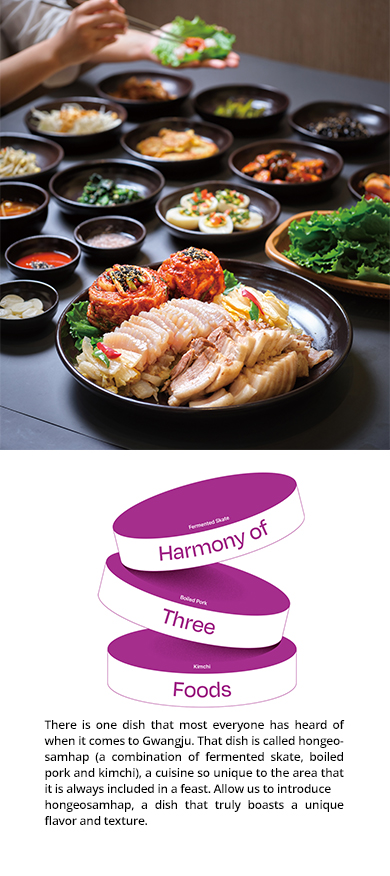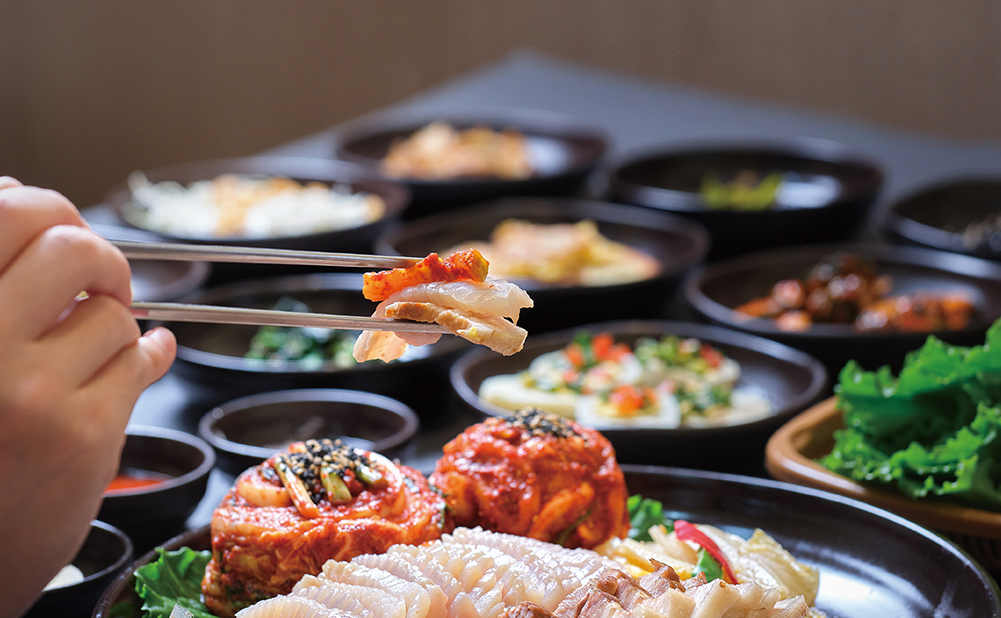June 2023

Local
Dining


The Unique Aroma of Hongeo
Hongeosamhap is a combination of three unlikely ingredients―fermented hongeo (skate), boiled pork and kimchi. As the name suggests, hongeosamhap is a dish mainly made with hongeo. People from Gwangju are so serious about the dish that they say “It’s not a party without hongeo.” That’s why the dish is always included in a feast. Samhap (a combination of three foods) was born naturally as people ate boiled pork and kimchi, which were served along with hongeo.
The trademark of hongeosamhap is the unique smell of hongeo that comes from the fermentation process. The fermentation process used for the dish ages the hongeo in a jar with straw and pine needles. Hongeo is aged for two to ten days at room temperature. People say that the aged hongeo releases a unique smell as ammonia is released. Similar fermented dishes include stinky tofu (China), pozole (Mexico), and surströmming (Sweden).
Fermented hongeo has a pungent smell, which can make it difficult to eat when trying it for the first time. But there’s really no need to worry. Boiled pork and kimchi go well with fermented hongeo.
There’s one market in particular to visit if you want to try fresh hongeosamhap. Yangdong Market in Gwangju is a large-scale traditional market that accounts for 90% of hongeo sold in Korea. There’s a street in the market that specializes in selling hongeo, which means you can watch it prepared fresh to order. Yangdong Market opens at dawn, so it’s best to visit early in the morning rather than the afternoon. Enjoy the lively atmosphere of Yangdong Market.

To fully enjoy hongeosamhap, you should take all three foods in a single bite.
A Flexible Food
How can fermented hongeo be delicious to eat? First, let’s take a look at the most basic way to enjoy the harmonious three foods. Pick up a piece of thick boiled pork, a piece of fermented hongeo, and a piece of ripe red kimchi. Put all three in your mouth and slowly savor the flavor. The slightly greasy taste of the boiled pork, the pungent aroma of the fermented hongeo and the chewy texture of the cartilage, and the ripe kimchi bring balance to each food. Three different foods become one in the mouth. The important thing is to take a bite and enjoy.
If you want to take on a more intense challenge, try hongeosamhap with hongeo that has been fermented for a long period of time. Hongeo has a different smell depending on the degree of fermentation; the more fermented it is, the more intense its smell becomes. The intense fragrance and the experience of having to blow your nose the moment you chew is a fun challenge. You can try the dish with different variations of kimchi and see what tastes best.
Kimchi makes the heavy-boiled pork and fermented hongeo taste refreshing. Hongeosamhap goes well with yeolmukimchi (young summer radish kimchi), gatkimchi (leaf mustard kimchi) or baekkimchi (white kimchi).
There’s something else that people recommend pairing with hongeosamhap: makgeolli (unrefined rice wine). It’s best to drink makgeolli the moment you smell the unique scent of fermented hongeo. The scent of fermented hongeo mysteriously disappears as the sweet scent of makgeolli takes over.
There are many ways to enjoy hongeosamhap as it comes with a lot of different side dishes. This can be referred to as jeong (affection) of Gwangju. Enjoy hongeosamhap with an abundance of side dishes and feel as though you have received a great gift.

(Left) Yangdong Market accounts for 90% of hongeo sold in Korea. (Right) Tasting the combination of various kinds of kimchi and hongeo is another way to enjoy hongeosamhap. © Gettyimages Korea
 View of all
View of all





